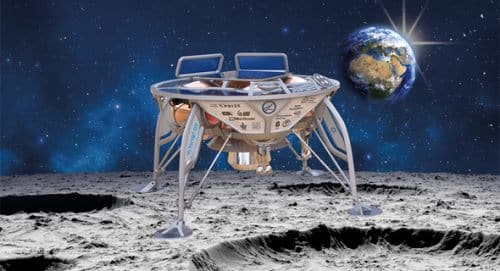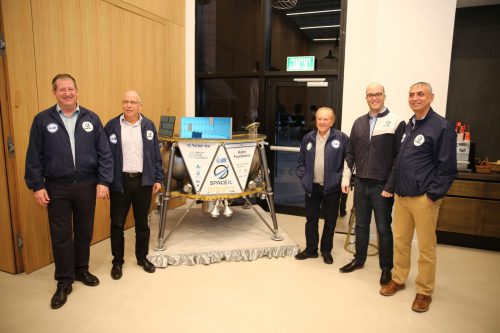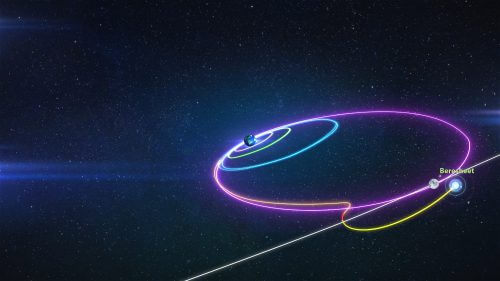From the moment the spacecraft is launched, it will begin a long and complex trajectory. The launch is expected to take place around 03:45 Israel time, when the Falcon rocket will take off and then the launch at Cape Canaveral out of the atmosphere. About 32 minutes later, the spacecraft will detach from the launch vehicle. After a few minutes from this critical point, if it does happen as planned, the spacecraft's first communication with the control room at the Israel Aerospace Industries facilities is expected

Today (Monday) the partners in the SpaceIL project and the Aerospace Industry announced that the launch of the Israeli spacecraft "Bereshit" will take place on 22.2.19, the night between Thursday and Friday, around 03:45, US time, East Coast - 21.2.19 around 20:45: XNUMX.
From the moment the spacecraft is launched, it will begin a long and complex trajectory. The launch is expected to take place around 03:45 Israel time, when the Falcon rocket will take off after the launch at Cape Canaveral and out of the atmosphere. About 32 minutes later, the spacecraft will detach from the launch vehicle. After a few minutes from this critical point, if it does happen as planned, we expect the spacecraft's first communication with the control room located in Yehud and that is how we will know that the spacecraft is alive. A few minutes later, the landing leg of the spacecraft will be opened, and later a series of tests will begin for all the spacecraft's systems to make sure that they have successfully passed the launch and are properly separated in space. About an hour after launch, the spacecraft will go into cruise mode on its first lap around the Earth.
It was a summary of eight years of work that began with a chance meeting of three engineers in a pub in Holon - Yariv Bash, Kafir Demari and Jonathan Weintraub, and started four years ago when the final design of the spacecraft was determined.
Thanks to the swift agreement signed between the Israeli Space Agency and NASA during the visit of NASA Administrator Jim Bardenstein in July 2018, they are giving SpaceIL people the opportunity to follow NASA's LRO lunar compass, thereby improving the algorithm that will be used to track Genesis. In addition, NASA gives the SpaceIL team and the Aerospace Industry the opportunity to use its deep space network, which includes huge antennas spread over the entire planet, so that it is possible to contact any spacecraft at any given moment. The CEO of SpaceIL, Dr. Ido Entabi, added in this context that this will make it possible to greatly increase the bandwidth and download much more information from the spacecraft in the few days it will operate on the lunar surface.

Maurice Kahn, president of the SpaceIL association: "We have been on this journey for about 8 years and it will be completed in about two months with the landing on the moon. We are making history and are proud to be part of a group that dreamed and realized the vision that many countries in the world dream of, but only three have realized it so far. Yesterday (17.2/100) we gave the "Genesis" project as a gift to the President of the country and it was declared a national project. There is no one prouder than me to give the people of Israel this gift and make it part of the Israeli ethos of technology, courage and a lot of audacity." He later detailed how the shutdown of the administration almost prevented the transfer of the spacecraft to the USA and all the attempts to help by President Rivlin, the US ambassador to Israel and Israel's ambassador to the US and even Jared Kushner did not help and only the resourcefulness of NASA employees made it possible to get the long-awaited approval. "If the spacecraft would not have arrived so the launch would be on time, the entire project would have been in danger of being canceled, and the XNUMX million dollars invested in it would have gone to waste." explained.
Ido Antavi CEO of the SpaceIL association: "Our journey to the moon is full of challenges, therefore our mission is complex like no other. Each step we pass successfully will pave the way for the success of the next step until landing on the moon. For many months, our teams and those of the Aerospace Industry were engaged in testing the spacecraft and its systems, in complex experiments and preparing for the mission. All this in order to be prepared for various scenarios during the mission, the success of which will bring national pride to Israel"
Nimrod Shafer CEO of IAI: "IAI's collaboration with SpaceIL is an example of the significant achievements that can be achieved in the State of Israel. The knowledge, skills and human capital are here, and the most distant regions can be reached. The road to the moon is fraught with challenges, but thanks to the professionalism, determination and faith of all partners in the project, an Israeli spacecraft will be launched in the coming days, and IAI, together with our partners at SpaceIL, will continue to do everything necessary to ensure the success of this mission."
The main challenges in the journey to the moon
According to Antavi, there are five main challenges for the spacecraft's journey to the moon: the first one, The launch phase is full of risks in itself. The second, Locating the position of the spacecraft and maintaining contact with it in the long range up to the moon. the third, The spacecraft's ability to withstand the extreme conditions in space, complex navigation (without GPS) and more. the fourth, The moon capture phase - a phase in which the spacecraft has to go from orbiting the earth to orbiting the moon. For this purpose, the spacecraft must arrive at the right place, at the right time, at the right speed and in the right direction, and this is in order to forget the gravity of the moon and trap it into a peripheral orbit. The last challenge is the most complex challenge - the soft landing on the moon.
The spacecraft will circle the ISS in elliptical orbits and will travel 6.5 million km - this is the longest orbit ever made to land on the moon. During these rotations, the spacecraft will raise its orbit around the Earth, until its edge reaches the vicinity of the moon. When the spacecraft will be trapped in lunar orbit about ten days Before landing, it will circle it until the appropriate timing and begin a landing process that will be carried out autonomously. As mentioned, the route will last about two months until the expected landing on April 11, 2019.

how it all began?
Although this is a national historical achievement, at its core is a private initiative that the three founders of the SpaceIL association conceived about 8 years ago with two main goals - one to land the first Israeli spacecraft on the moon and the other to inspire the younger generation to study science and technology.
The young entrepreneurs Yariv Bash, Kafir Demari and Jonathan Weintraub, aspired to realize their dream and registered for the challenging Google Lunar XPRIZE competition. The competition ended without a winner in March 2018, however SpaceIL has announced that it will continue the mission.
The first spacecraft in the world, built as part of a non-governmental mission
Since the establishment of SpaceIL, the mission to land an Israeli spacecraft on the moon has become a national project, but funded by donors, led by Mr. Morris Kahn. It is actually the lowest budget spacecraft ever to be launched for such a mission. The superpowers that managed to land a spacecraft on the moon invested billions of dollars in government funding.
The mere completion of the development, construction and testing of the spacecraft with such a limited budget is a significant achievement in itself, both for the State of Israel and for the space industry throughout the world. If indeed the mission is crowned with success, it will constitute a technological breakthrough on an international scale.
The significance of the project for the State of Israel
Landing a spacecraft on the moon will bring little Israel to an extraordinary achievement. The project brings to light her capabilities in the fields of technology and opens up many opportunities for her: beginning In educating the younger generation for science - since its foundation, the association has met more than a million students across the country. Second, for development and progress in science and research and third In the business aspect - a new horizon for the Israeli economy thanks to the engineering knowledge and advanced development capabilities. The success of Berashit is a symbol of the country's success in these and other fields.
The development and construction process
The process of designing and developing the spacecraft included the hard work of dozens of engineers, scientists and staff members. The full development phase began in 2015 at SpaceIL and the Aerospace Industry and continued until 2018. The spacecraft, which weighs only about 600 kg, is considered the smallest to land on the moon, the height of "Bereshit" is one and a half meters, it is about two meters wide and it carries fuel that is about 75 % of weight. Its maximum speed will reach 10 km per second (36,000 km/h).
The Israeli flag on the moon, a selfie and a scientific mission in collaboration with NASA, through the Israeli Space Agency
When the spacecraft carrying the Israeli flag lands on the moon, it will begin taking photographs of the landing site and taking a "selfie" to prove that we have indeed landed on the moon. Also, the spacecraft has an important scientific task that has not yet been done - measuring the moon's magnetic field, as part of an experiment carried out in collaboration with the Weizmann Institute and NASA.
The time capsule - a huge database of information about humanity as it is today
The spacecraft carries with it a "time capsule" - a huge database - hundreds of digital files starting with details about the association, about the spacecraft construction project and the team, national symbols, cultural cargo and materials collected from the general public over the years in order to send it to the moon with the spacecraft.
The time capsule will remain on the moon even after the mission is completed and since the spacecraft is not expected to return to Earth, the information contained in it will remain on the moon for an unlimited time, possibly being found and extracted by future generations. The capsule was manufactured by the Arch Mission Foundation (archmission.org) with special technology suitable for long-term survival on the moon.
Packing the spacecraft and transporting it to the launch site in the USA
In January 2019, the spacecraft was packed and flown to the launch site in the USA in a complex logistical operation. It was flown in a unique container, which underwent structural and engineering changes to fit the sensitive cargo. After arriving at Israel, it was loaded onto a temperature-controlled cargo plane and when the spacecraft landed in Orlando, USA, it was transported overland to the launch site in Florida.
partners and contributors The Aerospace Industry has been a full partner in the project since its inception. Over the years, additional partners were added from the private sector, government companies and academia. The most prominent among them: the Weizmann Institute of Science, the Israel Space Agency, the Ministry of Science, Bezeq and more. Among the main contributors to the project: Miri and Sheldon Adelson, Sami Segol, Lynn Schusterman, Sylvan Adams, Steven Grand and more. The one who took the lead to complete the mission and sees it as a mission, is the philanthropist and businessman Mr. Morris Kahn who financed about NIS 100 million and serves as the president of SpaceIL.

12 תגובות
Good morning Elijah, now you remember that there is no point in sending Genesis 2 because it will be "just another spacecraft"? Because of Project Artemis? There was no point in sending the first Genesis either, because NASA had already placed a man on the moon in 69! And since then at least 10 probes from other countries have been placed, so what was the point of sending an Israeli probe there? The goal we had to set for ourselves in advance was supposed to be much more grandiose than the moon in order to create interest for the public!
Can anyone shed light on the physical principles and reasons for the long route?
Live broadcast in English, by an American named Tim David, the "Everyday Astronaut" right here:
https://www.youtube.com/watch?v=F47Gu19a7Rc
Has extensive knowledge of rocketry and is fond of launches and space missions of all kinds. It is expected to explain quite a lot about what is around, and to answer questions that arise in the close chat (which has already started).
The broadcast will be carried out on the official broadcast of Space-X. The official Space-X broadcast will be here:
https://www.youtube.com/watch?v=XS0E35aYJcU
I also heard that channel 12 may broadcast.
Probably here 11
I still don't understand how a pile of electrical junk that can't rise on its own, can't return after landing on its own, is called a spaceship, call it a vacuum measuring device, not a spaceship
Will there be a live broadcast of the launch process?
In addition to that, there are not three astronauts on board the spaceship who must be provided with oxygen, water and food for the entire duration of the trip, and whose exposure to cosmic radiation must be reduced, so you can definitely take your time.
Because it is limited in its ability to carry fuel. With this method, you can run the engines for a few minutes each lap to bring the spacecraft to an orbit where one side is higher, until you reach the orbit of the moon.
I'm just asking why it will take two months for a spacecraft to land on the moon, compared to the journeys of the Apollo project in the late XNUMXs and early XNUMXs, which only took a few days?
Keeping my fingers crossed …
I have many criticisms of the government, but this is not one of them. It's not the United States launching, it's a private company SPACEX and the launch is done for a fee. You can do it too.
What is the final cost and how much did each body finance separately? Where can you find this data?
Another joke of the Likud and Netanyahu, the United States will launch a spacecraft for Israel